A few years ago, I spent 10 days camping in Yellowstone National Park. It was sooo nice to wake up each morning in the park. It made getting out to see the sights or go for a hike MUCH easier since we didn’t have to commute into Yellowstone. And for me, camping is the best way to experience nature!
On my June trip, I spent 3 nights in Mammoth, 3 nights in the backcountry and 3 nights at Norris. It was a bit of a last minute trip so we made due with what we could get. However… I always want to make sure I’m choosing the best option. So while we were touring around the park, I checked out most of the other campgrounds to see which campgrounds were awesome… and which were not.
I’ve put together a truly MASSIVE guide to camping in Yellowstone for you, updated for the 2024 season. It’s got literally everything you need to know including:
- How to make reservations for camping in Yelllowstone
- My recommendations for the best campgrounds in Yellowstone
- A detailed breakdown of what you’ll find at each of Yellowstone’s 12 campgrounds
- A complete list of all the campgrounds outside Yellowstone
- Rules and tips for camping in Yellowstone
This is a sensitive wilderness area. Learn how to Leave No Trace to keep the wilderness wild. Make sure you are prepared by bringing the 10 Essentials. Get ready for adventure with this checklist of things to do before every hike.
Hey there: Some of the links in this post are affiliate links, which means I earn a small commission at no extra cost to you if you make a purchase. Thanks for supporting my website! -Taryn
WANT MORE YELLOWSTONE INFO? Check out these posts:
- 70 Things to do in Yellowstone National Park
- The Ultimate Yellowstone Packing List for Every Summer Visitor
- Best Hikes in Yellowstone National Park
How to Make Camping Reservations in Yellowstone
There are three main types of campgrounds in Yellowstone: National Park-run campgrounds, privately-run Yellowstone National Park Lodges campgrounds, and backcountry campgrounds. You can drive up to the first two types but you’ll need to walk, paddle or ride a horse into the backcountry.
The reservation process for each type is different.
Yellowstone National Park-Run Reservable Campgrounds
These campgrounds are rustic – they don’t have showers and some do not have flush toilets. Scroll down for details about each campground.
A few years ago, all of these campgrounds were first-come, first-served. However as of 2023, all campgrounds run by Yellowstone National Park are reservable.
You can make reservations on Recreation.gov. You can make a reservation exactly six months in advance of the date you want to camp. So if you want to camp on July 15, the earliest you can make a reservation is January 15. If your dates are sold out, keep checking back. They do get last minute cancellations and sites open up again.
As well, some campgrounds have a handful of first-come, first-served sites. Some campground also have sites that can be booked two weeks in advance.
If you don’t get a reservation, don’t worry – you can use an app like Campnab to automatically scan the booking site, then send you a text or email when a site becomes available to book. Learn more about how these apps work in my guide to camping cancellation apps.
Yellowstone National Park-run campgrounds are:
- Indian Creek Campground
- Lewis Lake Campground
- Mammoth Campground
- Norris Campground (closed in 2024)
- Pebble Creek Campground (closed in 2024)
- Slough Creek Campground
- Tower Fall Campground (closed in 2024)
Yellowstone National Park Lodges Privately-Run Campgrounds
The Yellowstone National Parks Lodges campgrounds are run by a park concessionaire. They are not run by the parks service. These campgrounds are huge, with hundreds of sites. They all have flush toilets and RV-friendly sites and some have showers. Scroll down for details about each campground.
You can make reservations on the Yellowstone National Park Lodges website. They get fully booked up for the summer months in advance, so make a reservation as early as you can. (The earliest you can book is 13 months before your trip, starting on the 5th of the month. So if you want to book July 20, 2024, you can book starting on July 5, 2023.) If your dates are sold out, keep checking back. They do get last minute cancellations and sites open up again.
If you don’t get a reservation, don’t worry – you can use an app like Campnab to automatically scan the booking site, then send you a text or email when a site becomes available to book. Learn more about how these apps work in my guide to camping cancellation apps.
Yellowstone National Park Lodges-run campgrounds are:
- Bridge Bay Campground
- Canyon Campground
- Fishing Bridge RV Park
- Grant Village Campground
- Madison Campground
First-Come, First-Served Campgrounds in Yellowstone.
In previous years, many campgrounds in Yellowstone National Park did not accept reservations – they were available on a first-come, first-served basis. Starting in 2022, all camping is Yellowstone National Park is reserveable.
However starting in 2024, the Yellowstone National Park campgrounds have a few first-come, first-served sites and “secondary release” sites that are reserveable two weeks in advance. This makes last-minute camping possible.
- Indian Creek Campground – 20% of sites are available to reserve 2 weeks in advance.
- Lewis Lake Campground – 20% of sites are available to reserve 2 weeks in advance.
Another way to get last-minute camping is to hope some doesn’t show up or checks out early. If this happens, their site may become available. Check with the campground host at each campground to see if they have any sites available. Go early in the morning (before 8 a.m.) for the best chance of getting a spot.
Backcountry Campgrounds in Yellowstone
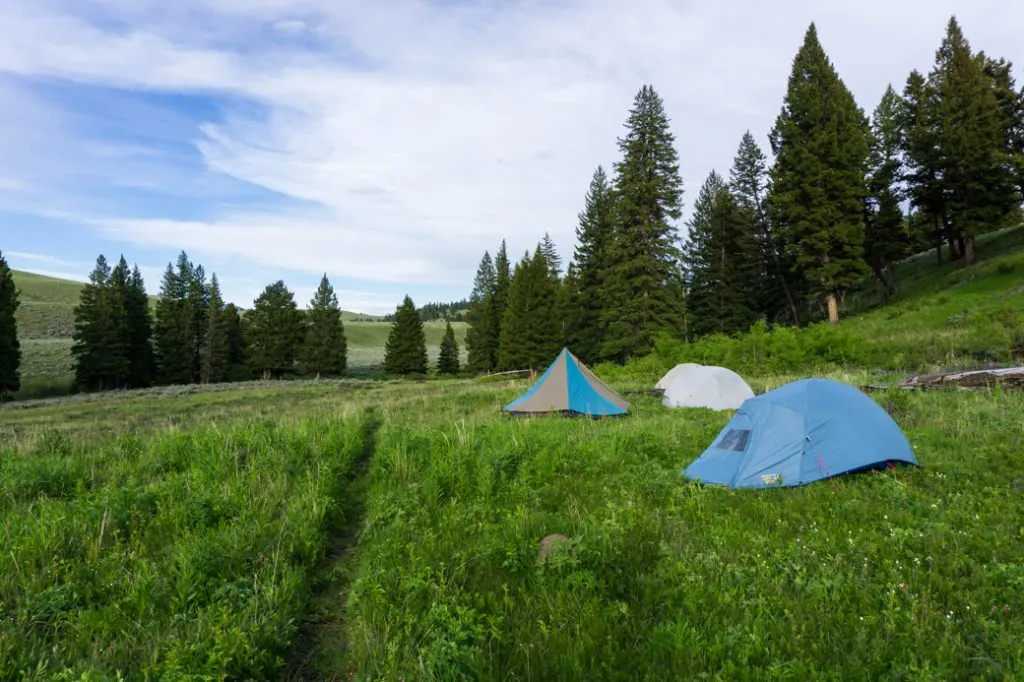
There are over 300 backcountry campgrounds in Yellowstone National Park that you can reach by foot, horseback or boat. Some of them are less than a mile from the road, while others are a LOT further.
I stayed at three of them along the Yellowstone River Trail during my trip to Yellowstone, and they were all pretty gorgeous.
However, info on backpacking in Yellowstone is outside the scope of this campground guide, so I won’t get into details. If you want more info, see the Backcountry Camping page on the Yellowstone National Park website.
Which Yellowstone Campground Should You Stay At?
That’s a tough question to answer. It really depends on what you are looking for in a campground. As well, Yellowstone is a REALLY big park so many attractions are hours apart. It might make sense to stay in one campground for a night or two, then move to another one to be close to other sights.
On my visit we stayed at Mammoth for three nights, then at Norris for three nights. I also visited most of the campgrounds just to see if we might want to consider trying to get a site there.
Here’s my campground-by-campground breakdown of each of the places to camp in Yellowstone National Park. I’ve got all the info on each campground so you can decide for yourself which Yellowstone campground is the best.
However, if you need some recommendations for the best campgrounds in Yellowstone, here are mine:
Most central campground: Norris (closed in 2024)
Best campground with showers: Canyon Village
Best Yellowstone campground for wildlife watching: Slough Creek
Best campground for RVs: Fishing Bridge
Details for Every Yellowstone Campground
Mammoth: $25/night, 82 sites, pit toilets, no showers, near Mammoth Hot Springs, reserve via Recreation.gov
Indian Creek: $20/night, 70 sites, pit toilets, no showers, near Mammoth Hot Springs, reserve via Recreation.gov
Norris: $25/night, 111 sites, flush toilets, no showers, near Norris Geyser basin, reserve via Recreation.gov (NOTE: closed in 2024)
Madison: $23/night, 276 sites, flush toilets, no showers, near Old Faithful, reserve via Yellowstone National Park Lodges
Grant Village: $39/night, 429 sites, flush toilets, showers, near West Thumb Geyser Basin, reserve via Yellowstone National Park Lodges
Lewis Lake: $20/night, 84 sites, pit toilets, no showers, near West Thumb Geyser Basin, reserve via Yellowstone National Park Lodges
Bridge Bay: $33/night, 431 sites, flush toilets, no showers, near Yellowstone Lake, reserve via Yellowstone National Park Lodges
Fishing Bridge RV Park: $89-$99/night, 310 sites (RVs only), flush, showers, near Yellowstone Lake, reserve via Yellowstone National Park Lodges
Canyon: $39/night, 272 sites, flush toilets, showers, near Grand Canyon of the Yellowstone, reserve via Yellowstone National Park Lodges
Tower Fall: $20/night, 31 sites, pit toilets, no showers, near Tower Fall, reserve via Recreation.gov (NOTE: closed in 2024)
Slough Creek: $20/night, 16 sites, pit toilets, no showers, near Lamar Valley, reserve via Recreation.gov
Pebble Creek: $20/night, 27 sites, pit toilets, no showers, near Lamar Valley, reserve via Recreation.gov (NOTE: closed in 2024)
Yellowstone Campground Map
Want to know where to find every single campground in Yellowstone? I made this custom Google map for you. It shows all the campgrounds in Yellowstone National Park as well as key attractions and places to buy groceries.
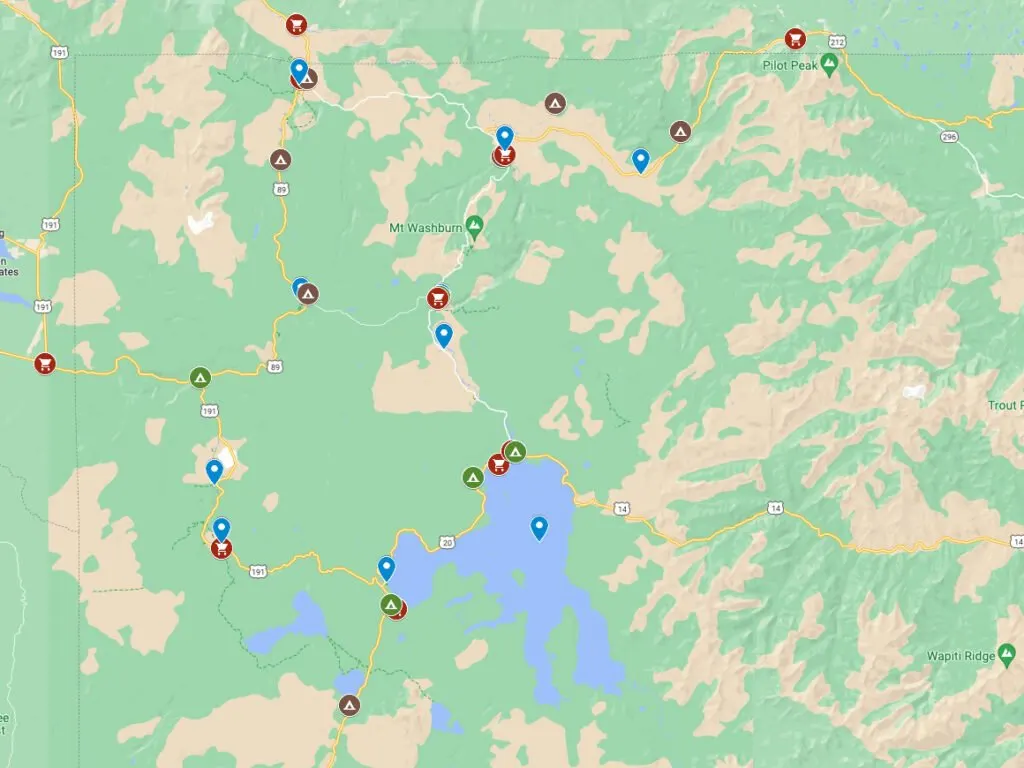
Mammoth Campground
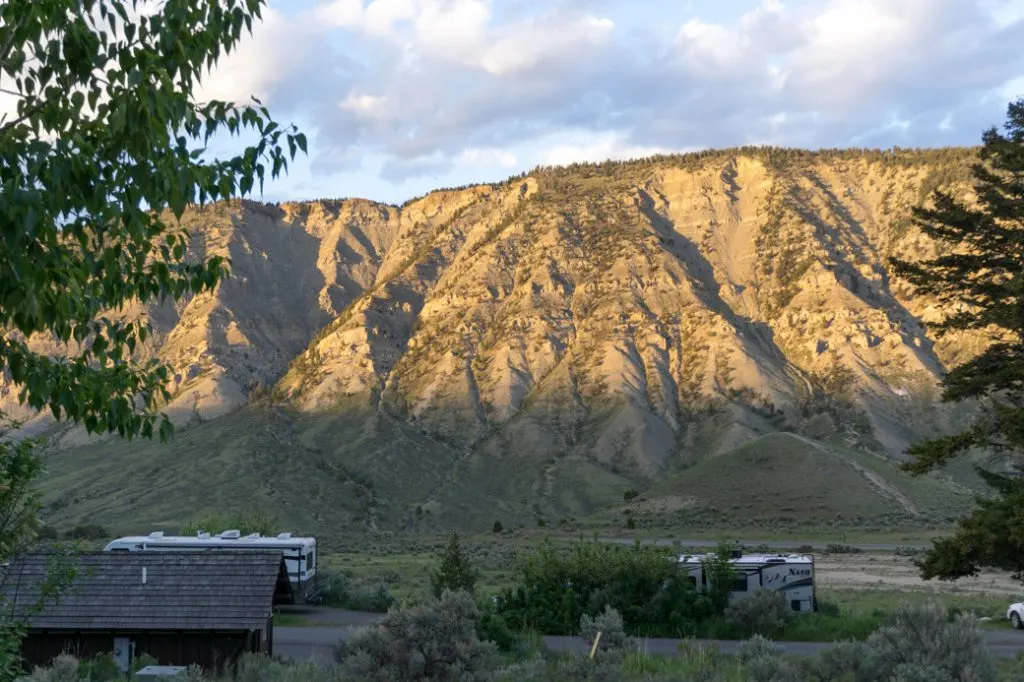
Open: Year-round (part of the campground is closed from mid-October to the end of March)
Reservations: Recreation.gov
Price: $25/night
Sites: 82 total.
RVs: Some sites will fit a max combined length of 40′ and a few will fit max 75′ combined length. Max 30′ in winter. Sites are pull-through or back-in and there may be limited width for slid-outs. Sites may not be level. No hookups.
Elevation: 6200 ft (1890m)
Amenities: Flush toilets, cell phone reception, generators allowed, amphitheater with ranger programs, firewood for sale. No showers. (Closest pay showers are at the Mammoth Hot Springs Hotel.)
Nearest Grocery Stores: Mammoth town, Gardiner, MT
Location: Mammoth Campground is in the northern part of Yellowstone National Park, just a few minutes from the north entrance at Gardiner, Montana.
Pros: It’s a good place to base for a night or two to see the sights in the northern part of Yellowstone. It’s easy to drive to Gardiner for groceries or a dinner out. The Mammoth area is very popular with elk, especially in the spring. You may even see elk in the campground. On my visit, there were protective elk mamas with calves hanging around. We had to give them a wide berth.
Cons: The Mammoth campground is in the middle of a long switchback in the main park road. This means that it is not very quiet as there is traffic going in and out of the park at all hours. If possible, request a site away from the road. The campground is in an open sagebrush environment with few trees. Some sites don’t have much shade and it’s pretty hard to string up a tarp in wet weather.
Indian Creek Campground

Open: Mid-June to early September
Reservations: Recreation.gov
Price: $20/night
Sites: 70 total.
RVs: 10 sites with 35′ combined length. 35 sites with 30′ combined length. Sites are pull-through or back-in and there may be limited width for slid-outs. Sites may not be level. No hookups.
Elevation: 7300 ft (2225m)
Amenities: Pit toilets. No generators allowed. no cell reception. No showers. (Closest pay showers are at the Mammoth Hot Springs Hotel.)
Nearest Grocery Stores: Mammoth town, Gardiner, MT
Location: Indian Creek Campground is south of Mammoth, but higher up in the mountains. From Indian Creek, it’s a 20-minute drive to Mammoth Hot Springs.
Pros: Indian Creek is a rustic campground so it’s great if you want a more natural experience. The no generator rule and the location away from the main road also makes it nice and quiet. It also is usually one of the last campgrounds to fill up. There is lots of tree cover at this campground, which is good for shade or stringing up a tarp on wet days.
Cons: There isn’t anything to do nearby. There are a few backcountry hiking trails in the vicinity, but unless you’re a hardcore hiker, you’ll need to drive a good distance to get to any of the sights from Indian Creek.
Norris Campground

NOTE: Closed in 2024
Open: Mid-May to late September
Reservations: Recreation.gov
Price: $25/night
Sites: 111 total, including some walk-in sites.
RVs: 2 sites with 50′ combined length and 5 sites with 30′ combined length. Sites are pull-through or back-in and there may be limited width for slid-outs. Sites may not be level. No hookups.
Elevation: 7,500 feet (2286 m)
Amenities: Flush toilets, generators allowed, amphitheater with ranger programs, firewood for sale. No cell reception. No showers. (Closest pay showers are at Canyon Village)
Nearest Grocery Store: Canyon Village General Store
Location: Norris Campground has a good central location on the western side of the park. It’s about 35 minutes to Mammoth, 25 minutes to Canyon Village, 55 minutes to Old Faithful and 55 minutes to Yellowstone Lake.
Pros: Norris is really central. It’s easy to see the whole park from here since most attractions are less than an hour drive. The only thing that is further is the Lamar Valley. The campground is located along the banks of a creek, which is really pretty. If possible, get a site in loop A or a walk-in for the best views. Bison often hang out in the area, so you might be able to spot them grazing without leaving your campsite. There is also a 1-mile trail directly from the campground to Norris Geyser Basin so you don’t have to deal with finding a parking spot there.
Cons: Norris is really popular and can fill early. As well, some of the sites are really close together (especially the walk-in sites), so they don’t feel that private.
READ NEXT: Best Hikes in Yellowstone National Park
Madison Campground
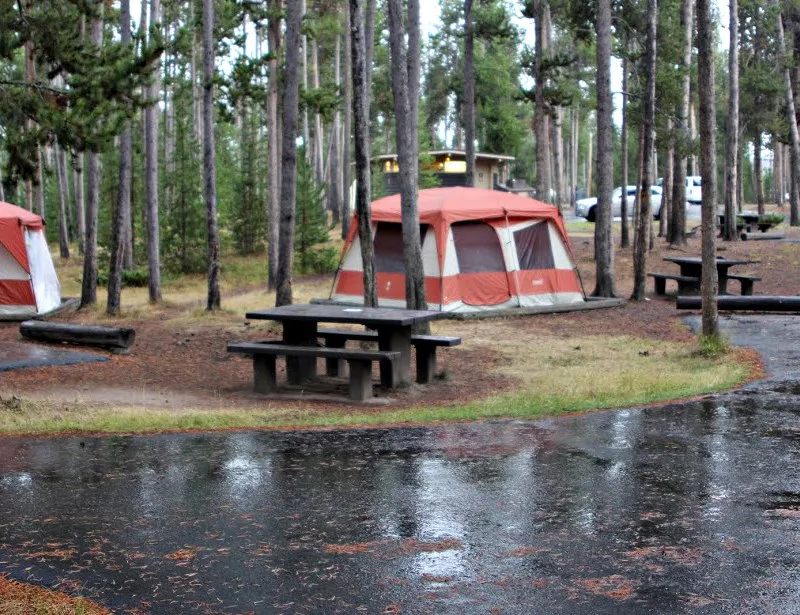
Open: Early May to mid-October
Reservations: Yellowstone National Park Lodges
Price: $33/night + tax.
Sites: 276 total.
RVs: Some sites will fit rigs up to 40′ long. Sites are pull-through or back-in. There may be limited clearance for slide-outs and not all sites are level. No hookups.
Elevation: 6,800 feet (2073 m)
Amenities: Flush toilets, generators allowed, amphitheater with ranger programs, firewood for sale, dump station. No cell reception, no showers. (Closest pay showers are at the Old Faithful Lodge.)
Nearest Grocery Store: West Yellowstone, MT
Location: Madison Campground is just 25 minutes from the west entrance of the park. It’s also only about 30 minutes to Old Faithful. It’s about an hour to Mammoth, an hour to Yellowstone Lake and 45 minutes to Canyon Village.
Pros: Camping at Madison puts you within an easy drive of all the major geyser basins on the west side of the park. It’s also not that far from Mammoth, Canyon Village or Yellowstone Lake. And if you need a bit of civilization, its easy to drive out of the park to West Yellowstone to get dinner at a restaurant. The campsites are also near the Madison River, which is good for fishing.
Cons: There’s not too much to do nearby. There are a few hiking trails (Harlequin Lake and Purple Mountain), but otherwise, you’ll have to drive everywhere from your site. Loops G and H (for tents only) are the quietest. The rest can get a lot of road noise from the highway to West Yellowstone. As well, since the campground has hundreds of sites, it can feel crowded as the sites are close together.
Grant Village Campground

Open: Early June to mid-September
Reservations: Yellowstone National Park Lodges
Price: $39/night + tax
Sites: 429 total.
RVs: Some sites will fit rigs up to 40′ long. Sites are pull-through or back-in. There may be limited clearance for slide-outs and not all sites are level. No hookups.
Elevation: 7,800 feet (2377 m)
Amenities: Flush toilets, cell reception, generators allowed, amphitheater with ranger programs, firewood for sale, two free showers a night, dump station.
Nearest Grocery Store: Grant Village
Location: Grant Village Campground is situated on the west shore of Yellowstone Lake. It’s part of the large Grant Village community that includes a visitor centre, hotel, grocery store, marina, restaurant, and gas station. West Thumb Geyer Basin is a 5-minute drive. It’s also about 40 minutes to Old Faithful.
Pros: You can walk over to Grant Village from your campsite to check out the visitor centre, buy groceries or go to the restaurant. If you are into boating, the location on Yellowstone Lake is great. Grant Village is also an easy drive to Old Faithful. If you get a spot towards the end of loops E, G, H, or on the north side of I, you’ll be really close to Yellowstone Lake
Cons: Loops J, K, L and get road noise from the highway south to Grand Teton National Park. The sites are small and close together, without too much privacy. Being located in the south of the park means this campground is a far drive from many attractions.
Lewis Lake Campground
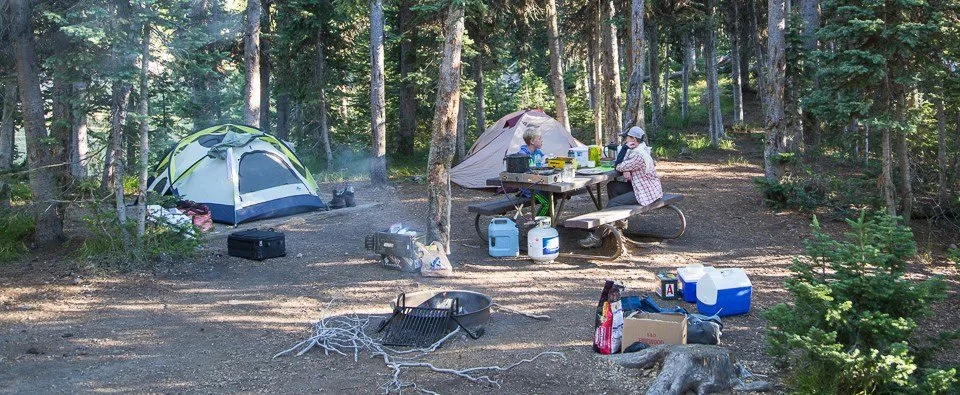
Open: Late June to late October
Reservations: Recreation.gov
Price: $20/night
Sites: 84 total including some walk-in sites.
RVs: Some sites fit RVs 25′ combined length or less. Sites are pull-through or back-in. There may be limited clearance for slide-outs and not all sites are level. No hookups.
Elevation: 7,800 ft (2377 m)
Amenities: Pit toilets. No cell reception. No generators allowed. No showers. (Closest pay showers are at Grant Village.)
Nearest Grocery Store: Grant Village
Location: Lewis Lake Campground is on the shores of Lewis Lake in the southern part of Yellowstone. It’s a quiet part of the park, but Grant Village is only 20 minutes away. It’s a longer drive to the rest of the park.
Pros: Lewis Lake is popular with boaters. It’s also the gateway to the backcountry of Shoshone Lake, which is only open to canoes and kayaks. The campground is rustic with no generators and pit toilets, so it’s great if you want a more natural experience. It also tends to fill up later than other campgrounds.
Cons: This is the southern-most campground in the park. That makes it the farthest away from most attractions.
READ NEXT: 70 Things to do in Yellowstone National Park
Bridge Bay Campground
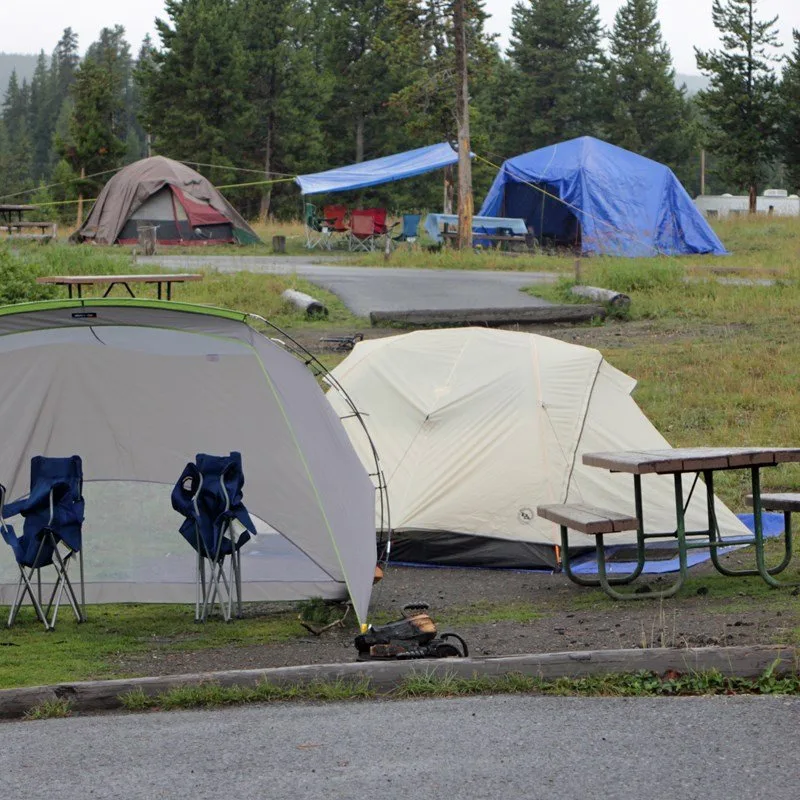
Open: Mid-May to early-September
Reservations: Yellowstone National Park Lodges
Price: $33/night + tax.
Sites: 431 total.
RVs: Some sites will fit rigs up to 40′ long. Sites are pull-through or back-in. There may be limited clearance for slide-outs and not all sites are level. No hookups.
Elevation: 7,800 ft (2377 m)
Amenities: Flush toilets, cell reception, generators allowed, amphitheater with ranger programs, firewood for sale, dump station. No showers. (Closest pay showers at Grant Village and Fishing Bridge RV Park.)
Nearest Grocery Store: Lake Village, Fishing Bridge
Location: Bridge Bay campground is located on the northern part of Yellowstone Lake in the southern part of the park. The Bridge Bay Marina is right next door. It’s a short drive to Canyon Village and West Thumb Geyser Basin, but other sights are much further away.
Pros: This is a good campsite to choose if you brought a boat since the marina is nearby. It’s a short drive to Lake Village and Grant Village if you need groceries or want to eat at a restaurant. And you can hike the popular Natural Bridge Trail right from your campsite.
Cons: Many of the campsites are very close together with no privacy since there aren’t many trees. As well, some people have complained that the tent sites are not very level. Being located in the south of the park means this campground is a far drive from many attractions.
Fishing Bridge RV Park
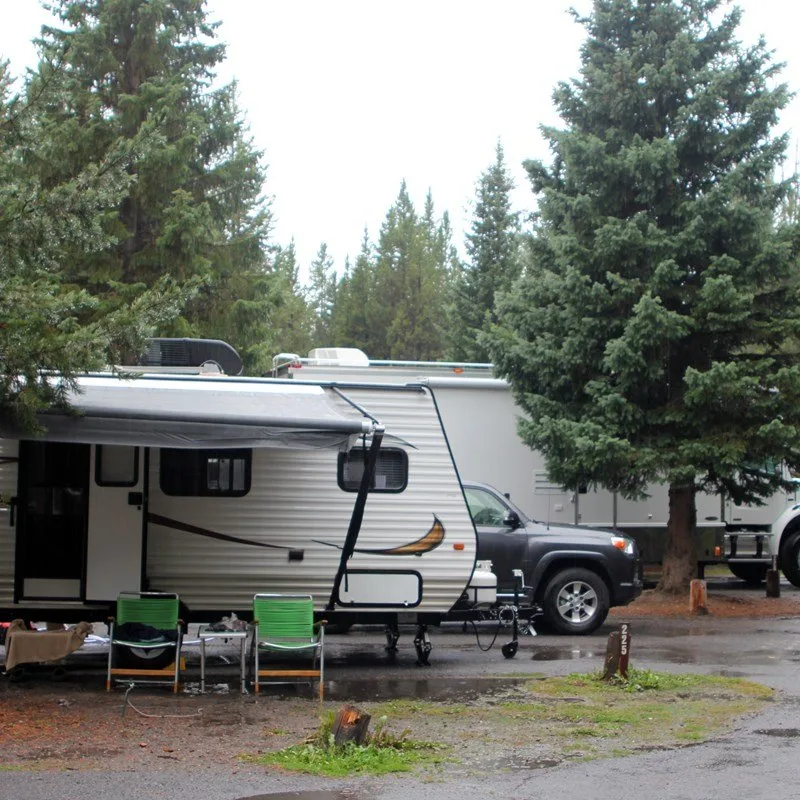
Reservations: Yellowstone National Park Lodges
Price: $89-$99/night + tax and utility fees
Sites: 310 total for hard-sided RVs only. No tents. No tent-trailers.
RVs: Sites are 30-95′ long. Most sites are pull-through. 30′, 35′ and 40′ sites are back-in and some allow for side-by-side parking of truck and unhooked trainer. Full hookups for electricity, water, and sewer (50 or 30 amp).
Elevation: 7,800 ft (2377 m)
Amenities: Flush toilets, cell reception, generators allowed, amphitheater with ranger programs, pay showers, full hookups, dump station. No campfires allowed.
Nearest Grocery Store: Lake Village, Fishing Bridge
Location: Fishing Bridge RV Park is at the north end of Yellowstone Lake. It’s close to the Fishing Bridge over the Yellowstone River and a general store. Lake Village is a short drive away. It’s a short drive to Canyon Village and West Thumb Geyser Basin, but other sights are much further away.
Pros: If you camp in an RV and want full hook-ups, this is your only option for that in Yellowstone National Park. The campground got a complete renovation (finished in 2022) with larger sites, bigger parking lot, new dump station, more showers and laundry, and updated comfort stations.
Cons: The campground is set up like a traditional RV Park with rigs parked very close together. The hard-sided RV requirement is because grizzly bears frequent the campground. You aren’t allowed to have a campfire at these sites, which is a bummer on cold nights.
Canyon Campground
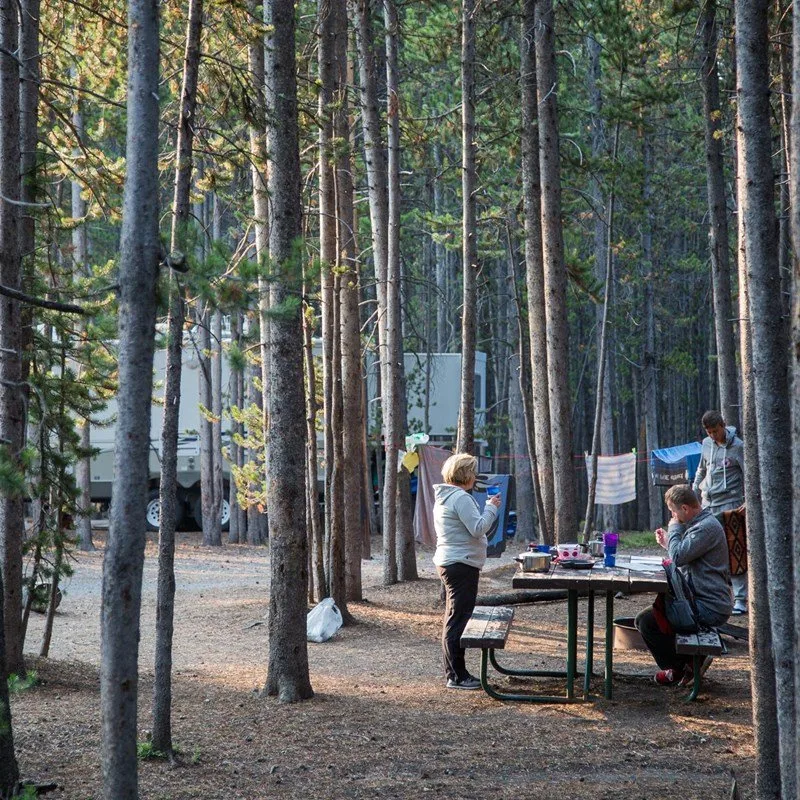
Open: Late-May to mid-September
Reservations: Yellowstone National Park Lodges
Price: $39/night + tax
Sites: 272 total.
RVs: Some sites will fit rigs up to 40′ long in pull-through and back-in sites. There may be limited clearance for slide-outs and not all sites are level. No hookups.
Elevation: 7,900 feet (2408 m)
Amenities: Flush toilets, cell reception, generators allowed, amphitheater with ranger programs, firewood for sale, two free showers a night dump station.
Nearest Grocery Store: Canyon Village.
Location: Canyon campground is located in Canyon Village near the north rim of the Grand Canyon of the Yellowstone. It’s a pretty central location on the east side of the park.
Pros: Canyon Village is within walking distance of the campground and it has a grocery store and restaurants. The campground is away from the village and the main road so it is quiet. If you don’t want to worry about parking on the canyon rim, you can follow a trail one mile from the campground through the cabins to the North Rim.
Cons: The sites are small and close together. As well, people complain that some of the sites aren’t very flat.
READ NEXT: The Ultimate Yellowstone Packing List for Every Summer Visitor
Tower Fall Campground
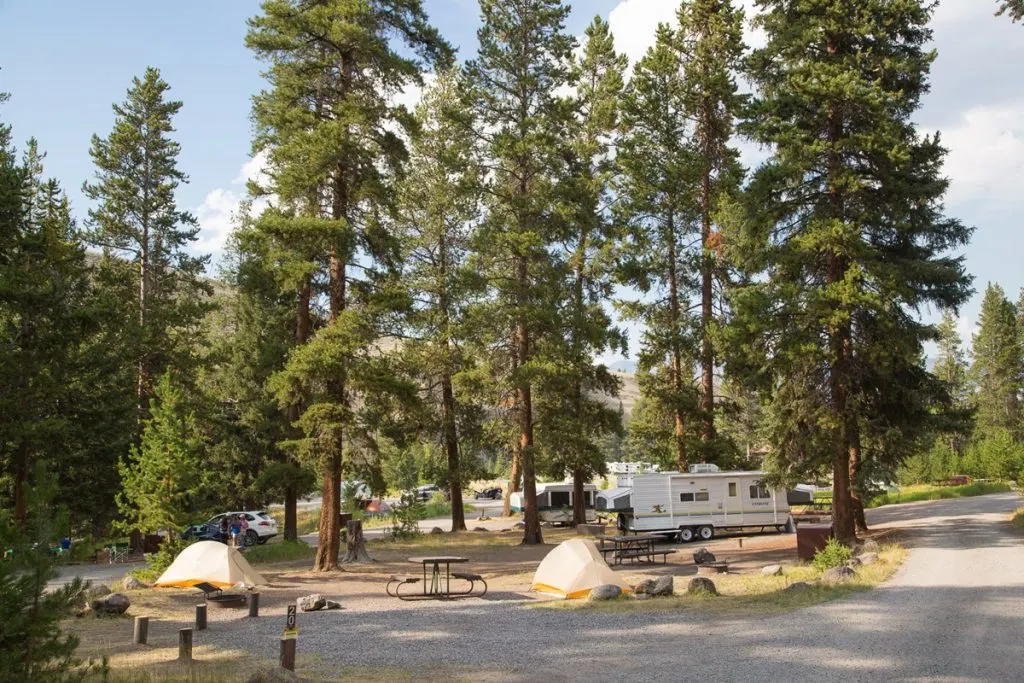
NOTE: Closed in 2024
Open: Late May to late September
Reservations: Recreation.gov
Price: $20/night
Sites: 31 total.
RVs: Best for rigs 30′ combined length or less due to a hairpin curve. There may be limited clearance for slide-outs and not all sites are level. No hookups.
Elevation: 6,600 feet (2012 m)
Amenities: Pit toilets, amphitheater with ranger programs. No cell reception, no showers, no generators allowed. (Closest pay showers are at Roosevelt Lodge.)
Nearest Grocery Store: Tower Fall
Location: Tower Fall campground is located across the road from Tower Fall in the northern part of Yellowstone. It’s a 10-minute drive away from Tower Junction and the Roosevelt Lodge.
Pros: It’s a small campground so it won’t feel crowded. You can walk to Tower Fall from your campsite. If you want a restaurant meal, the Roosevelt Lodge is a short drive away.
Cons: The sites are smaller so they are better for tents, not RVs (although shorter RVs are permitted.)
Slough Creek Campground
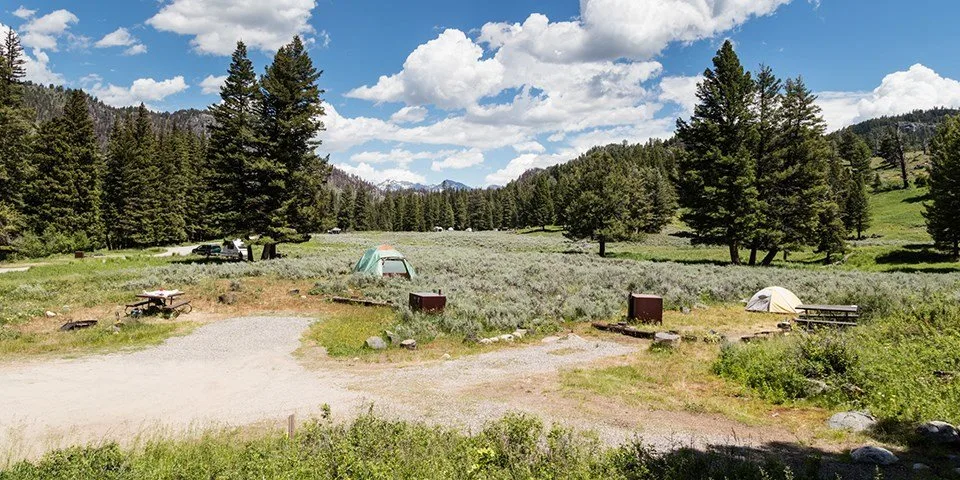
Open: Mid-June to mid-October
Reservations: Recreation.gov
Price: $20/night
Sites: 16 total.
RVs: 14 sites fit rigs up to 30′. There may be limited clearance for slide-outs and not all sites are level. No hookups.
Elevation: 6,250 feet (1905 m)
Amenities: Pit toilets. No cell reception, no showers. (Closest pay showers are at Roosevelt Lodge.)
Nearest Grocery Store: Tower Fall
Location: Slough Creek is located on a gravel road in the northeast part of Yellowstone. It is in the Lamar Valley, one of the park’s best wildlife watching destinations. Since it’s the remote northeast of the park, it’s not near any of the other attractions.
Pros: There is a wolf den nearby so this is the best place in the park to try to spot a wolf. Bison, bears, pronghorn, and elk are also common. It’s a small and quiet campground with a wilderness feel.
Cons: RVs won’t really fit in this campground. (Although very small rigs may fit.) This campground is a long drive from the rest of the park and frequent bison jams can make the drive even longer.
Pebble Creek Campground

NOTE: Closed in 2024
Open: Mid-June to late September
Reservations: Recreation.gov
Price: $20/night
Sites: 27
RVs: Some sites have long pull-throughs that will accommodate RVs. There may be limited clearance for slide-outs and not all sites are level. No hookups.
Elevation: 6,900 feet (2103 m)
Amenities: Pit toilets. No cell reception, no showers. (Closest pay showers are at Roosevelt Lodge.)
Nearest Grocery Store: Tower Fall, Cooke City
Location: Pebble Creek Campground is in the northeast corner of Yellowstone at the foot of the Absaroka Mountains. It’s a 20-minute drive to Cooke City, MT on the eastern edge of the park. Otherwise, it’s not near anything else in the park.
Pros: Pebble Creek is a small and quiet campground with a wilderness feel. There’s a pretty little creek right in the middle of the campground. Nearby Soda Butte Creek is popular with anglers. It’s also close to the wildlife mecca of the Lamar Valley.
Cons: It’s a LONG drive to the rest of the park.
Campgrounds Outside Yellowstone National Park
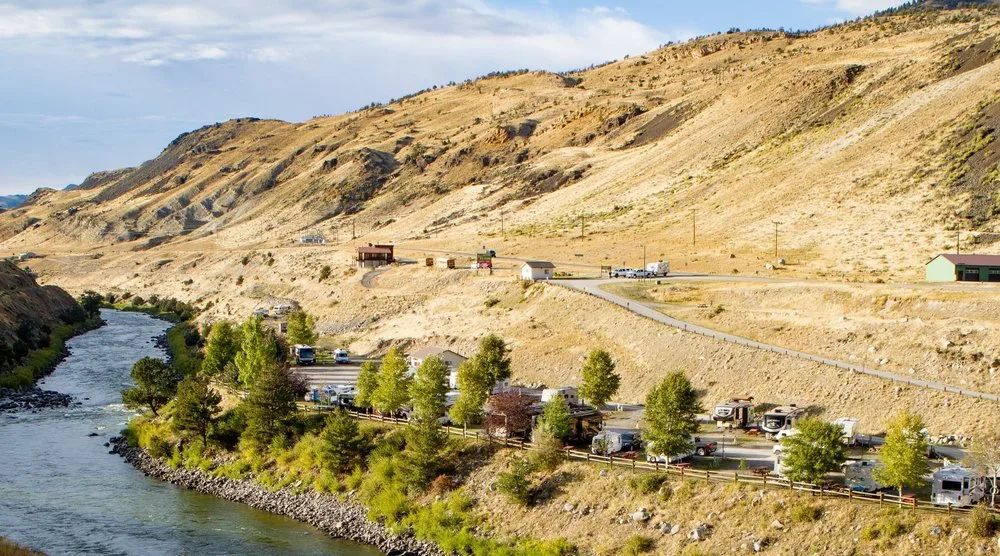
If you can’t get a campsite inside the park, you aren’t out of camping options. There are first-come, first-served campgrounds in the National Forests outside Yellowstone. There are also RV parks in some of the nearby towns. I haven’t visited any of these, so I can’t give you any recommendations. But here’s the list of all the campgrounds near Yellowstone I know of, sorted by which park entrance they are closest to:
North Entrance:
- Eagle Creek Campground, Custer Gallatin National Forest (reserveable)
- Sun Outdoors Yellowstone North (reserveable)
- Yellowstone RV Park (reserveable)
Northeast Entrance
- Soda Butte Campground, Custer Gallatin National Forest (first-come, first-served)
- Colter Campground, Custer Gallatin National Forest (first-come, first-served)
- Chief Joseph Campground, Custer Gallatin National Forest (first-come, first-served)
East Entrance:
- Threemile Campground, Shoshone National Forest (reserveable)
- Eagle Creek Campground, Shoshone National Forest (first-come, first-served)
West Entrance:
- Yellowstone Cabins and RV Park (reserveable)
- Yellowstone Grizzly RV Park and Cabins (reserveable)
- Wagon Wheel RV Cabin Campground (reserveable)
- Yellowstone Park West Gate KOA (reserveable)
- Buffalo Crossing RV Park (reserveable)
- Baker’s Hole Campground, Custer Gallatin National Forest (first-come, first-served)
South Entrance:
- Headwaters Campground at Flagg Ranch (reserveable)
- Lizard Creek Campground, Grand Teton National Park (reserveable)
Yellowstone Campground Rules and Tips
In most ways, camping in Yellowstone is a lot like camping in any other National Park. Except for the bears… and a few other things. Here are some tips and rules you need to know about camping in Yellowstone. And to get you in the camping mood (and help give you a better idea about what campsites look like in Yellowstone) here’s a somewhat cheesy National Parks video about camping in Yellowstone.
Campfires in Yellowstone
Each campsite at all campgrounds except Fishing Bridge RV Park has a fire ring. However, there may be season fire-bans during dry summers when the fire danger is high.
You can buy firewood at some campgrounds. Keep in mind that the firewood kiosk may only be only open in the evening from 6 to 8 pm. You can also buy firewood at most stores and gas stations in the park.
Drinking Water at Yellowstone Campgrounds
There are water taps in all campgrounds in the park. It’s fresh mountain water and is safe to drink. You can fill up there or water bottle refill stations at visitor centres. There’s no need to bring wasteful and expensive bottled water!
Group Size at Yellowstone Campgrounds
You are only allowed to have six people per campsite. If you have more than that, you’ll need more campsites.
RVs in Yellowstone
Most campgrounds in Yellowstone accept RVs. RVs are welcome at all of the campgrounds. Just make sure you book a spot that is big enough to accommodate your rig – many won’t fit longer RVs and have maximum length restrictions. Check site details when making a reservation.
Bear Safety in Yellowstone
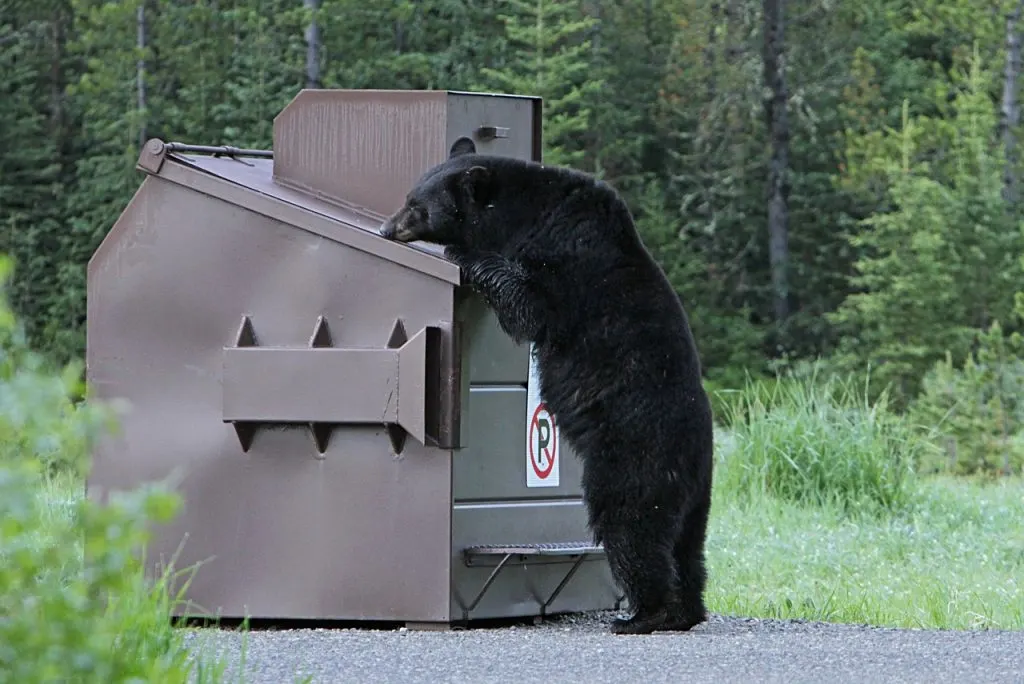
All of Yellowstone’s campgrounds have strict bear safety rules. You’ll get an info sheet about it when you check in to your campsite, and maybe a mini-lecture too! The reality is that bears walk through all the campgrounds.
To ensure the safety of campers and bears, you have to protect all your food and smelly stuff. Of course, bears (and other critters) are interested in your food, but they might also like your dishes, pots, stove, drinks, cooler, pet food, garbage, and toiletries.
Unless you are actively using them, you need to put those items away. You can’t leave them sitting out in your campsite or store them in your tent. You can put them in your car or you can store them in the bear-proof storage box.
The bear-proof storage boxes are large metal lockers big enough to store a few large coolers. In most campgrounds, you’ll get your own, but in some of the reservable campgrounds, you will need to share them between 2 or 3 campsites.
If a ranger or campground host finds unattended food or smelly items in your campground, you could get a fine or a ticket. They will also put your gear away for you. We saw that happen to three different groups during our trip! For more tips, read my post about bear safety for campers and hikers.
READ NEXT: Bear Safety for Hikers, Campers and Backpackers
Camping With Dogs in Yellowstone National Park
Dogs are allowed in Yellowstone National Park and at campgrounds, but there are quite a few restrictions. They must be in a car, in a crate, or on a leash that is less than six feet long.
Dogs are allowed on leash within 100 feet of roads, parking lots, and campgrounds. Dogs are not allowed on hiking trails or boardwalks. You are not allowed to leave your dog unattended in a car or tied to an object.
What to Pack for Camping in Yellowstone National Park
All of Yellowstone’s campgrounds are above 6000 feet so it can get cold at night. As well, it can rain at any time in the mountains. Make sure you’re prepared. For my recommendations on what to bring camping, see my Yellowstone Packing Lists.
READ NEXT: How to Stay Warm in a Tent: Over 40 Tips
So that’s everything you need to know about camping in Yellowstone. I know you’re going to have an AWESOME trip! If you have any questions, please leave them in the comments section. I’ll be happy to answer!
READ NEXT:
- 70 Things to do in Yellowstone National Park
- The Ultimate Yellowstone Packing List for Every Summer Visitor
- Best Hikes in Yellowstone National Park
- The Best Camping Cancellation Apps
- 25 Things to do in Grand Teton National Park
- How to Stay Warm in a Tent: Over 40 Tips
- How to Paddle the River of Golden Dreams in Whistler, BC - July 26, 2024
- Tips for Safe Hiking in Wildfire Season - July 25, 2024
- 10 Things To Do in Bonavista, Newfoundland - July 25, 2024

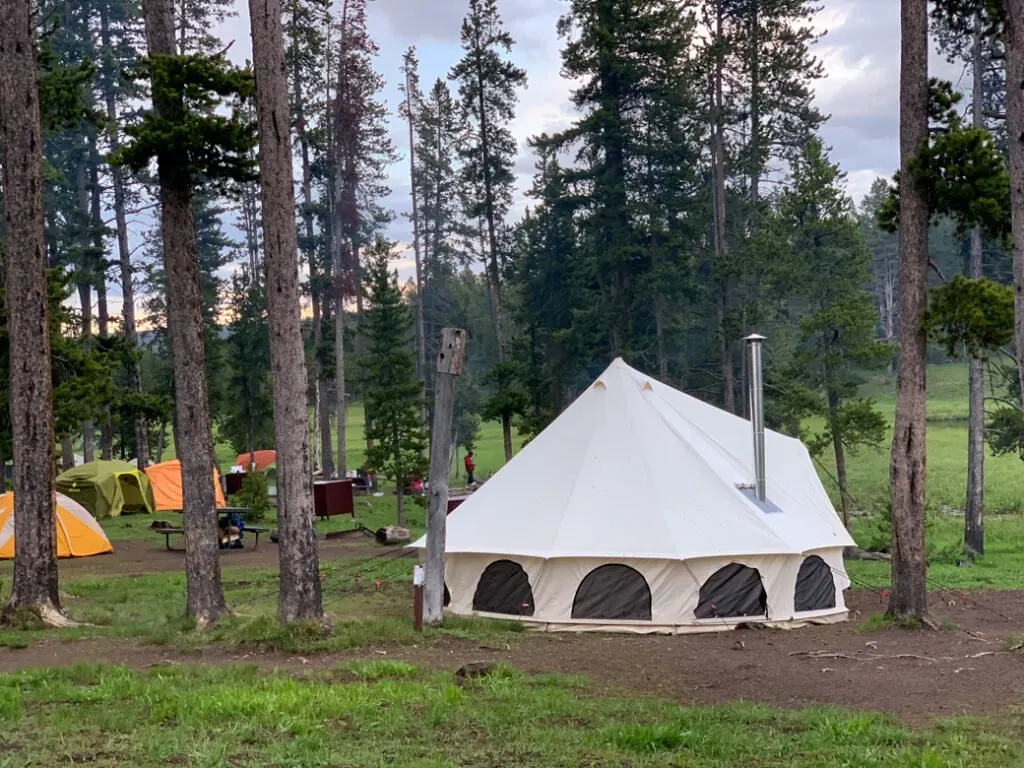
Jan
Thursday 21st of March 2024
I want to thank you for the time and effort that you put into creating this article. Well written and documented. The interactive map is fantastic. This has been the MOST HELPFUL item I have used to create our Yellowstone trip. Thank you, thank you, thank you.
Elizabeth
Thursday 21st of March 2024
What are overnight temp ranges in early May?
Taryn Eyton
Tuesday 26th of March 2024
Average temperatures in May are highs of 53°F and lows of 28°. For early May you may also want to consider average temperatures for April which are highs of 46°F and lows of 19°F. It's also worth noting that the only campgrounds in the park that are open early May are Mammoth and Madison.
Mylène
Tuesday 3rd of January 2023
Thank you so much for this post! So helping!
Mark
Thursday 8th of December 2022
Not sure how old this Yellowstone article is, but some of the information may be out of date. The National Park Service (NPS) has apparently gone back to first come, first served for all of its campgrounds. They are using a scan and pay system starting in 2023. Campers who arrive at one of their campgrounds will use an app available on the Recreation,gov website to scan a QR code on the site they choose to stay at. This was confirmed to me by an agent on the Reservation.gov website chat. Not sure why they are going back to first come, first served. For those of us travelling long distances I prefer to have a reservation. There are 12 campsites in Yellowstone, 7 of which are managed by the NPS. The other 5 campgrounds are managed by Yellowstone National Park Lodges. The Lodges website seems to still show their campgrounds as reservable.
Taryn Eyton
Friday 9th of December 2022
Thanks for the info Mark. I update this post every few months to reflect the latest info. The last update was in October and that info wasn't available. I'll update the post to make sure it has the latest info for the 2023 season.
Ronald Collins
Saturday 22nd of October 2022
What is the maximum length for a recreation vehicle at Yellowstone?
Taryn Eyton
Sunday 23rd of October 2022
Most campsites fit RVs with a combined length of less than 30'. A handful of sites at each campground are bigger - see the detailed campground listings in this post to see which campgrounds have bigger sites and what their max length is. If you have a big RV, you should plan to book at site at Fishing Bridge RV park. The biggest sites there are 95' long.